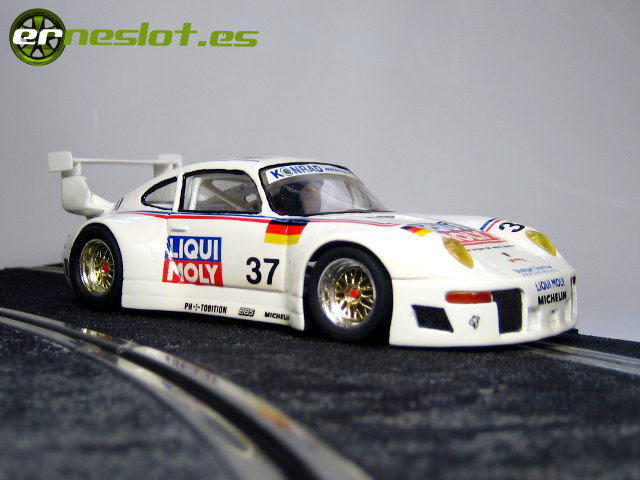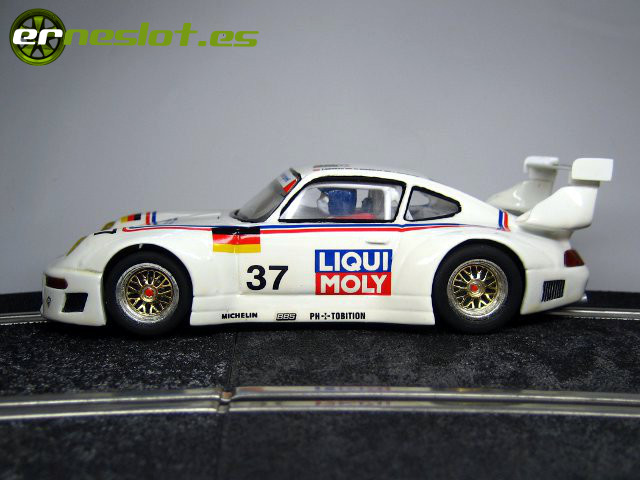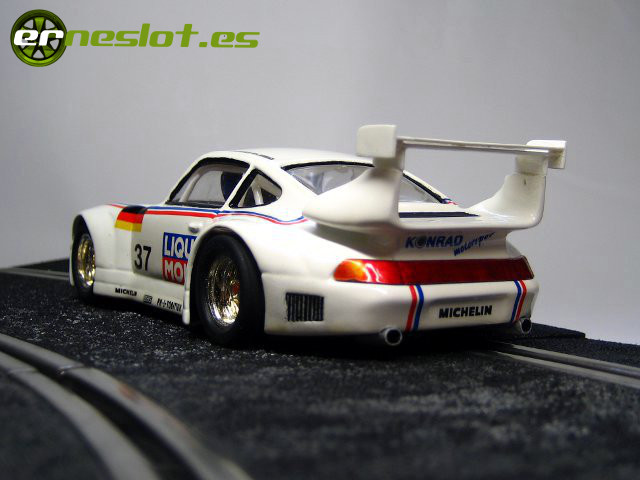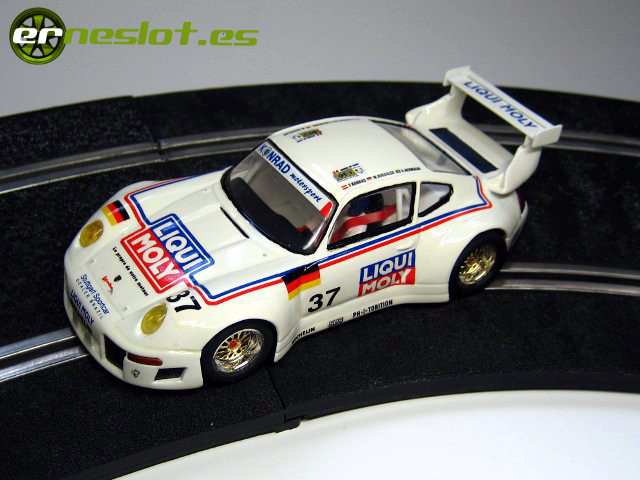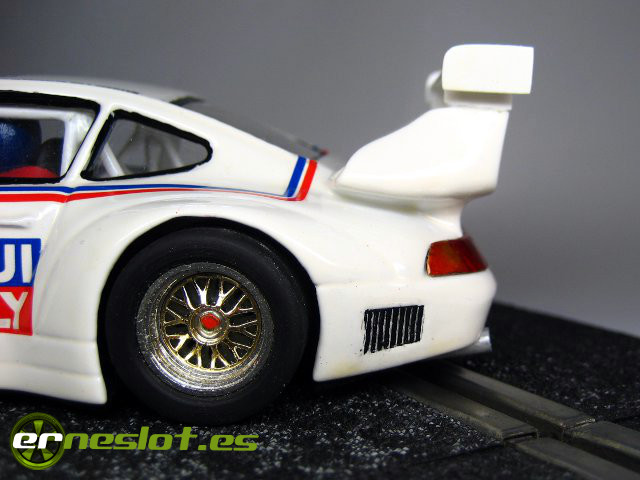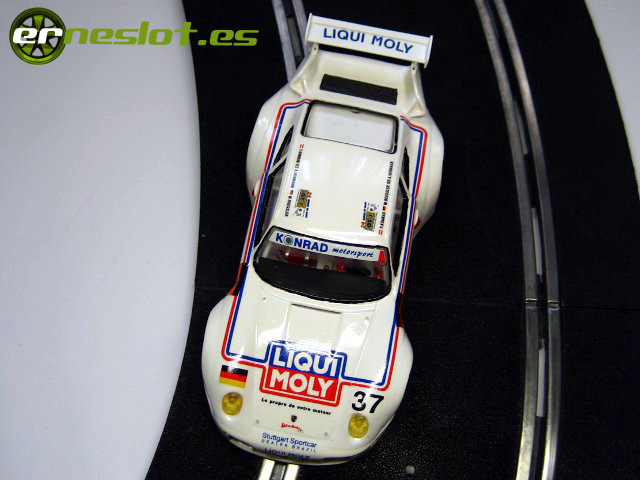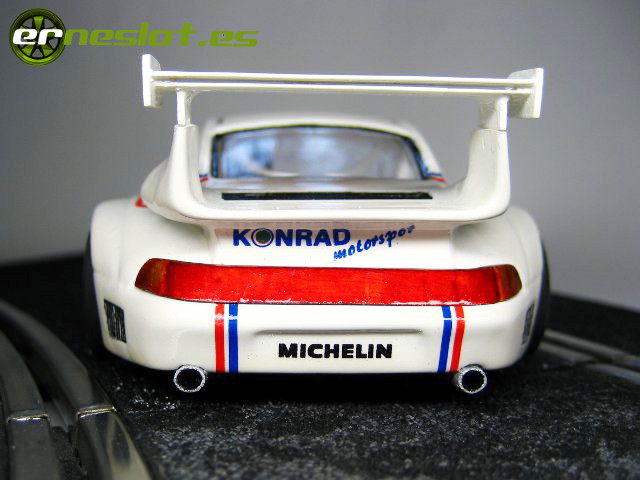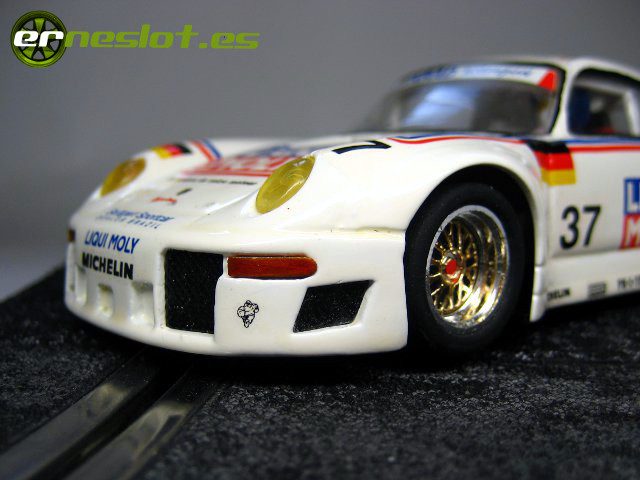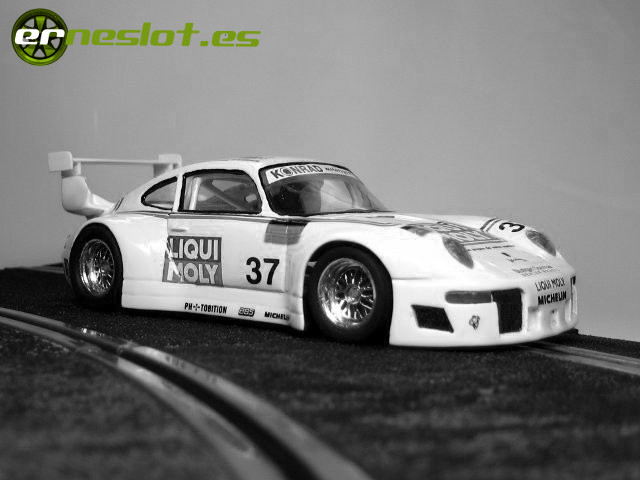Porsche 993 GT2, 1996 Le Mans 24 h.
The fourth generation of the Porsche 911, with internal code 993, was introduced in 1993 and represented a major change in the appearance of the model and bring forward some radical change that would give the look 911 in 1997 with the appearance of the series 996. A more fluid line, with headlights more inclined and less prominent, and the bumper perfectly integrated into the body were the most relevant changes. The inside was left with few changes from the previous model. Mechanically, the changes in the new series affected the brakes, suspension geometry and engine, with increased engine capacity to 3600 cc. was the last series to equip air-cooled engines.
While, in 1994 the FIA changed the rules of endurance racing for both prototypes (LMP1 and LMP2) and for GT cars, which created four categories, GT1 to GT4, depending on the preparation of cars. Porsche decided to modify the 993 to homologate it in GT2 category (also did the same with GT1) and build a racing-client car who allowed participate in endurance races with guarantees.
Based on the turbo model, with the intention to save weight lifted the front wheel drive. The 3.6 engine was fitted two smaller KKK turbos, one for each cylinder bank, thanks in part to the improved electronic engine management offered by a new switchboard, and an increase in the blowing pressure of the turbos to 0.9 BAR, the engine power output reached 430 hp. Moreover, from the 3.8 RS model (another of the developments on the 993 series) took the brakes, suspension geometry and aerodynamic changes.
Externally the car has very advanced aerodynamics, with a front spoiler that included an oil cooler, wheel arches, made of fiber, bolted to the body to
facilitate replacement in the race, and a spectacular two-plane rear spoiler with two "ram-air" type air intakes on each side.

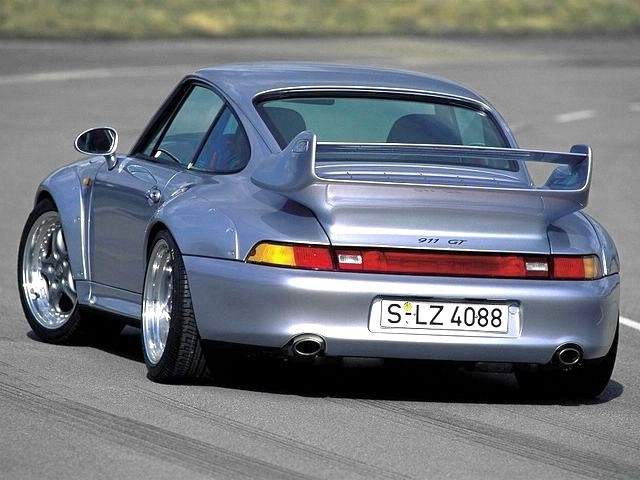
The model in question were manufactured 57 street version units and another 21 more developed, while about those who that were destinated to the competition were produced 110 units. One was acquired by the Konrad Motorspor team to participate in the 24 Hours of Le Mans in 1996, having the Liqui Molly company of lubricants as main sponsor and Franz Konrad, Antonio Hermann and Wido Rossler as drivers. The car was entered in the GT1 class as they faced the Porsche 911 GT1 in addition to the army of Lister Storm, McLaren F1 GTR, Venturi 600, Dodge Viper, Ferrari F40 and even a curious Renault Spider V6. In the race, qualified for the start at the 34th position but not finished due to an accident. This is a picture of the car at 1/43 scale:
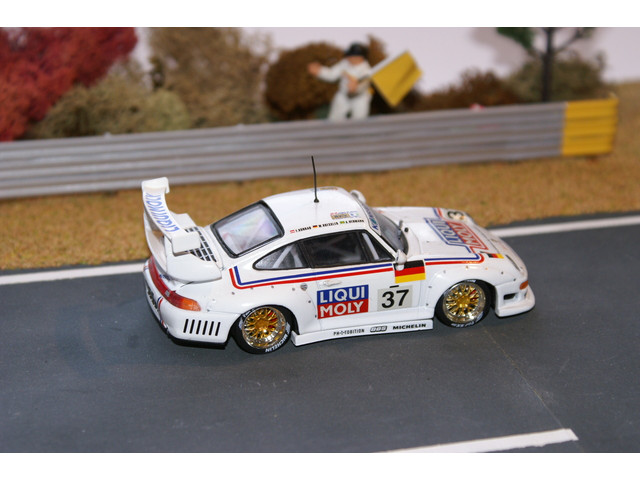
At 1/32 scale the model was reproduced by Scalextric in their stage of Tyco, very badly indeed, and more recently by ProSlot with a much more successful model. Their outward forms are quite good but poor in details while the interior was inadequate, with a drivers tray that even let in the light mechanics. At least the car´s handling on the track was very good. This is the car that will depart for the decoration:
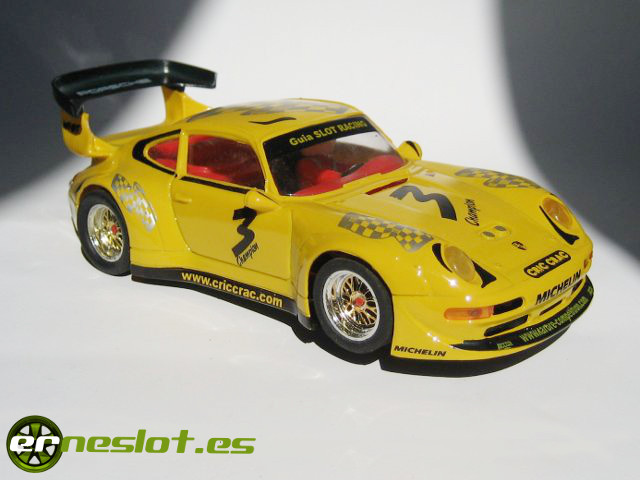
Dismantle the car was easy, because as you can see in the picture below isn´t made up of many parts. More difficult was trying to remove the original paint of the car, and there was no way to remove it from the body, I tried to soak it burn alcohol, soak it in rubbing alcohol, rub with a rag soaked in acetone, leaving four hours sprayed with oven cleaner foam... and there was no way to remove the painting, only was able to remove a little the black pad printing and some logos, but the yellow paint was impossible to remove. So I decided to give him a few gentle strokes used fine sandpaper (grain 500) to eliminate the brightness of the original painting and to remove some burrs from the mold.
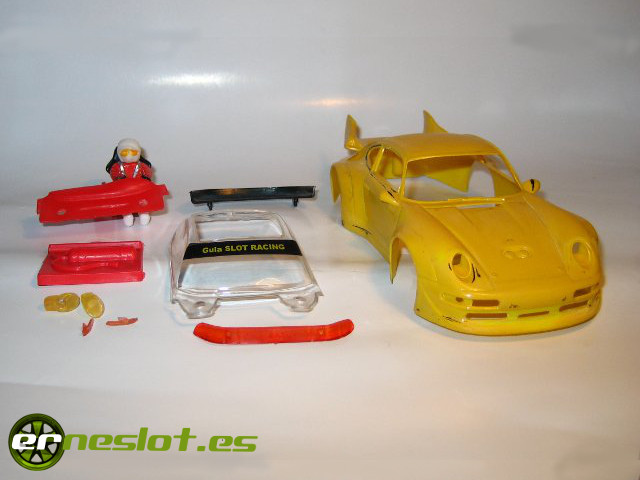
When decorate a car I don´t like to confine to paint and place the decals. Always can make small improvements to the model to get it closer to real car. They aren´t radical changes, only small details to improve the car. In this particular model, the differences were confined mainly to the front spoiler, the number of openings and and vents that had the real car weren´t the same as in the scale model.
To make the front as the original car opened the holes with the appropriate form and hit two component putty where needed, in the center of the spoiler and the hood to cover air intakes and the gas caps.
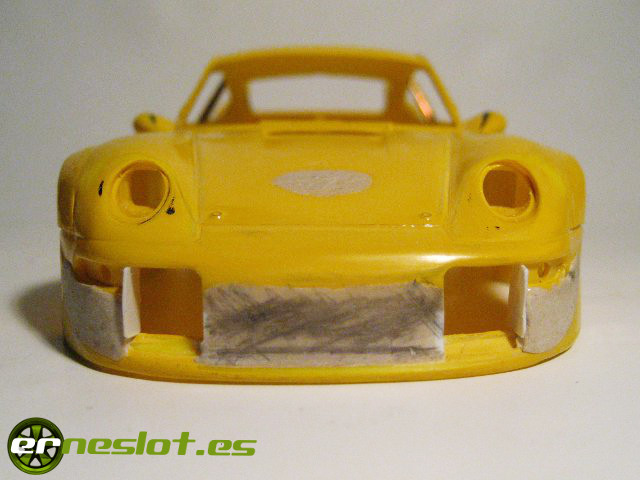
Slowly and carefully followed to opening the rest of the holes of the front with a mini drill and a small file. In addition small pieces of plastic stuck where appropriate.
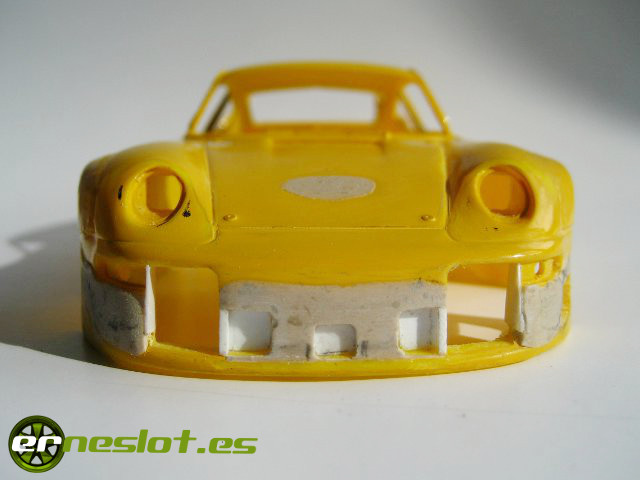
At the sides of the bumper opened other holes that the car had.
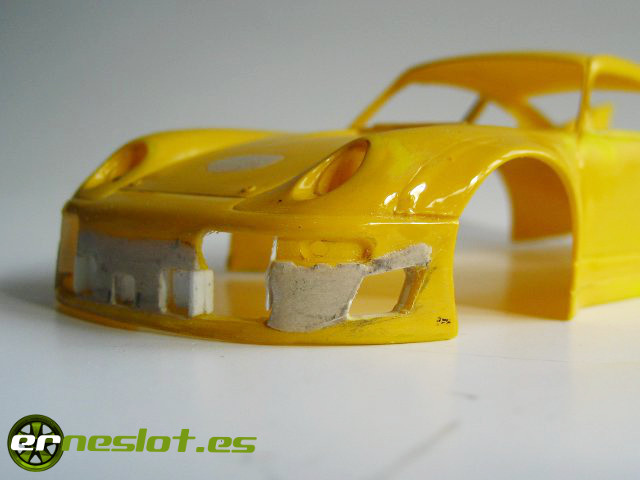
And once all the holes open with their correct form, I cloned a grid with polyurethane resin from a chassis that was in the drawer. Once cloned, I cut to fit to the holes where it will be placed.
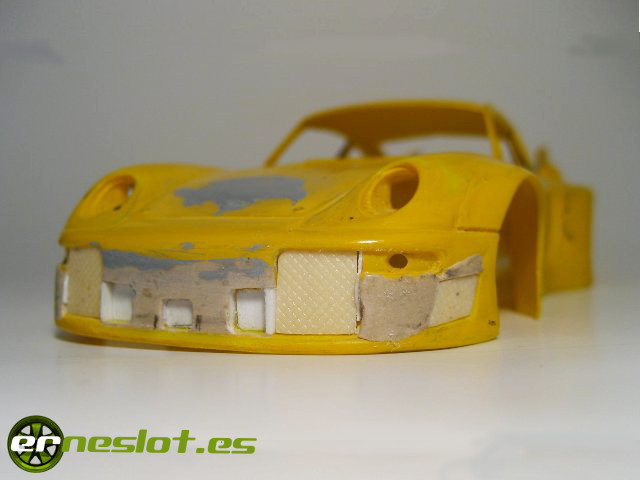
As I did in the front bumper, opened a hole for the rear bumper grid,...
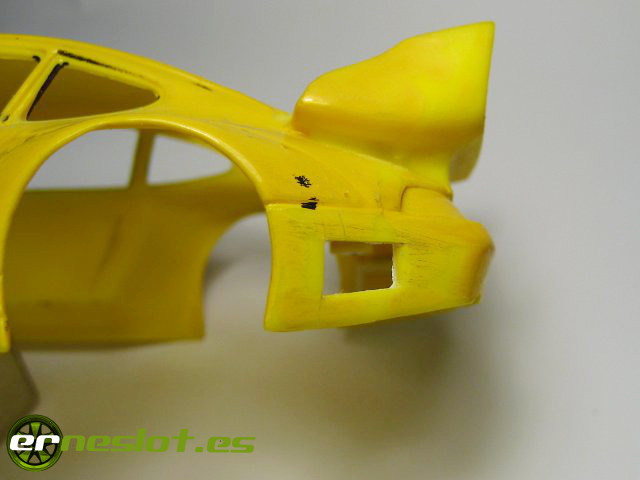
...hole where I adjusted other grid, also cloned from other in polyurethane resin.
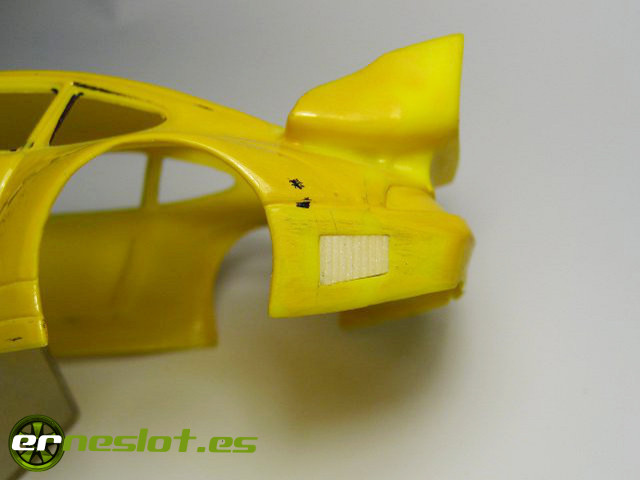
With all the holes open and grids glued in place, I applied a coat of white Vallejo primer spray.
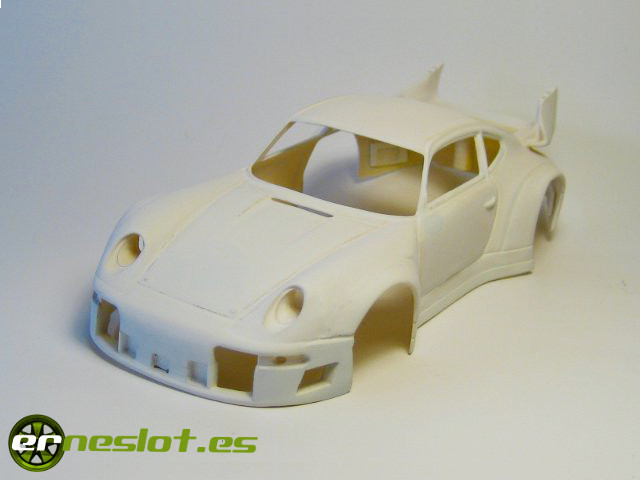
The primer showed few faults in the body, somewhat logical since the changes were few. With a little bit of putty and used sandpaper used I corrected them. After a pass of soft sand, and then apply another coat of white primer to match the tone of the body (Tamiya putty is gray...) before painting with the paint itself.
The painting as I do with cars that are whites was Dupli-color spray, work very well and covers well. As like with the primer, apply two coats, with a soft pass with sandpaper between them.
Once thoroughly dry the paint, I painted the little details of the bodywork (rear bumper air outlets, and window gums) with Vallejo black paint and a fine brush.
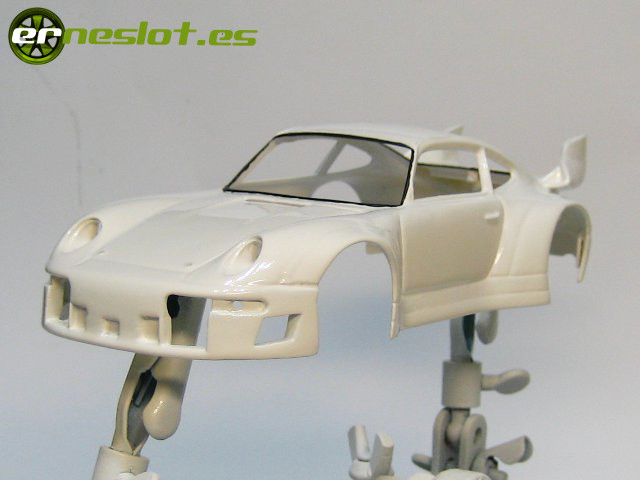
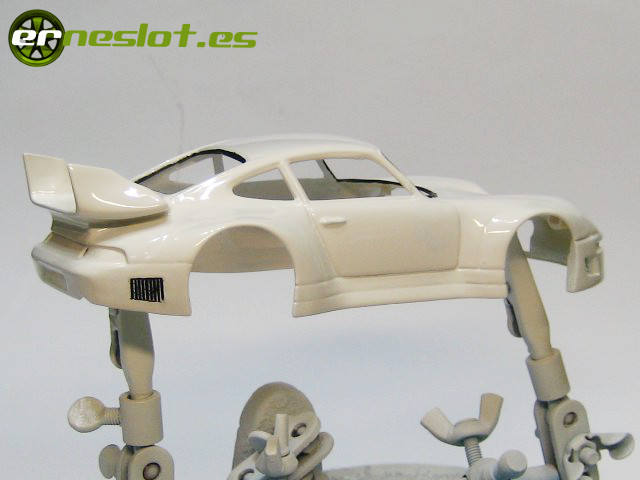
The decals to decorate the car are commercial, from DMC (reference DMC-32014). They are pretty good but I miss some logos, like the Porsche shield the hood, and one of the logos are not well scaled, such as "Michelin" dolls, are rather small.
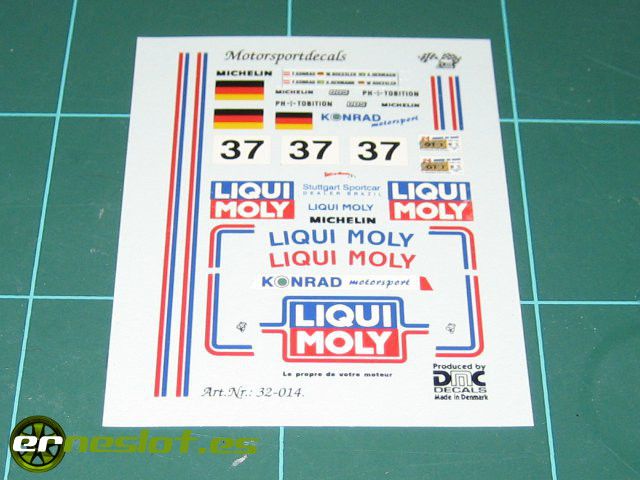
As expected, the decals hadn´t any complication, are very resistant and were only somewhat more complicated to put the side lines due its length, but little else. A little bit of Microsol and Microset in some places, such as the joints of the doors and the car was ready for varnish.
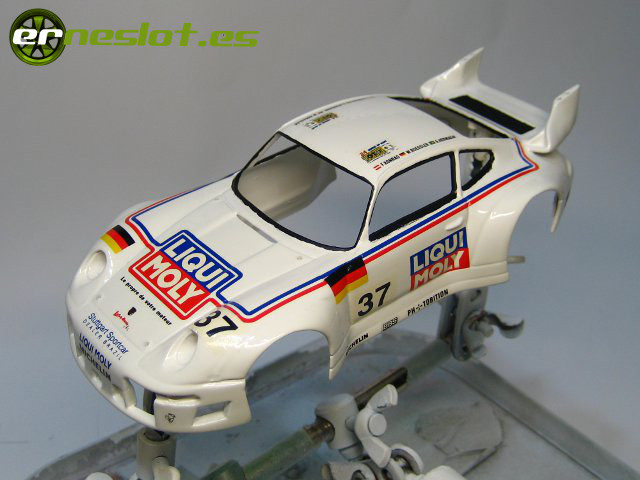
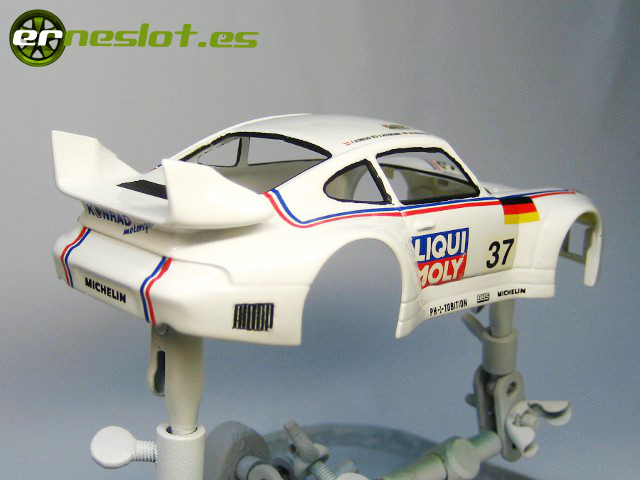
Taking advantage of drying time of the decals before varnishing made the car roll cage with evergreen rods glued together with superglue and bicomponent glue in some places.
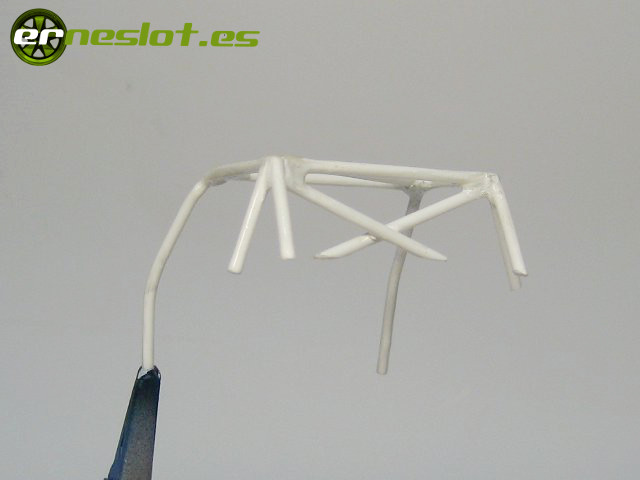
And also decorated the details of the bodywork, headlights and air intakes.
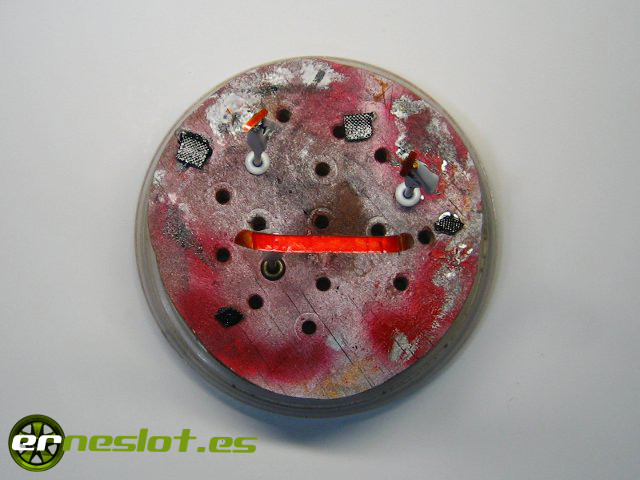
For the car made a complete interior as explained in section "Creating a complete interior for a slot car" in the techniques and tricks section, and you can see by clicking here.
The interior, once decorated, looks like this:
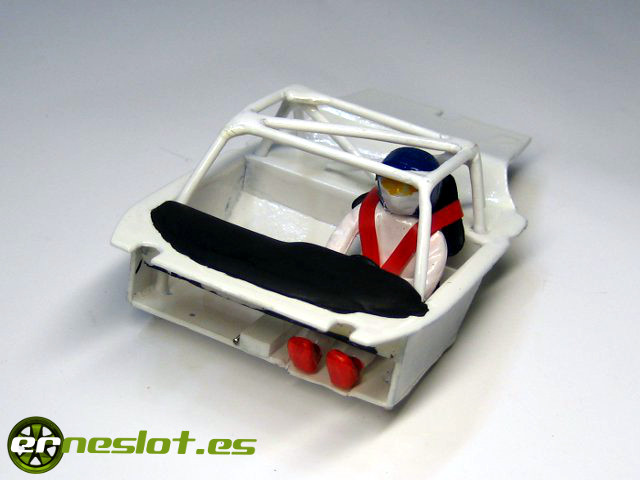
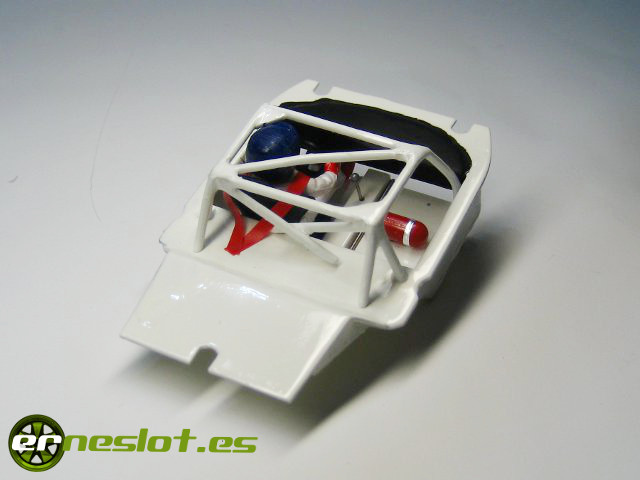
To my taste the result was only acceptable.., a bit bland. I wasn´t very inspired at that moment, with a poor decoration, the driver´s seat, a fire extinguisher made with a rod made of evergreen, the shift know made with a pin and some more.
To finish, needed to build the rear wing. The original from the scale model wasn´t like the real car one:
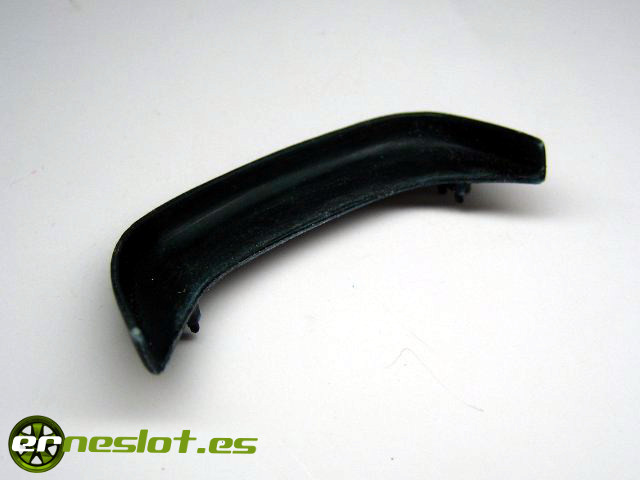
, so I made a new one with evergreen strips glued together:
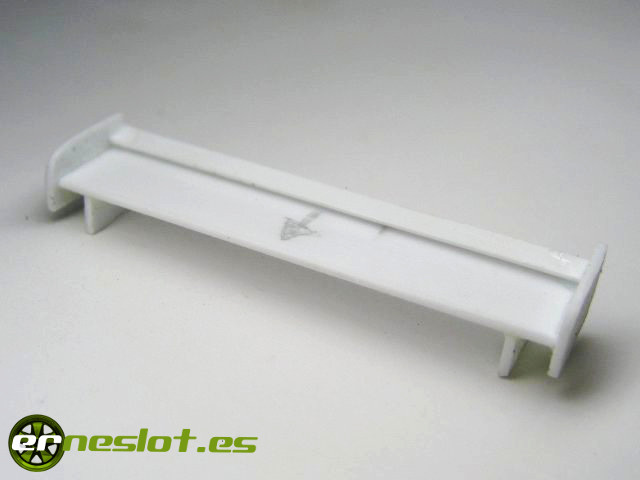
once painted and the waterslide decals placed becomed:
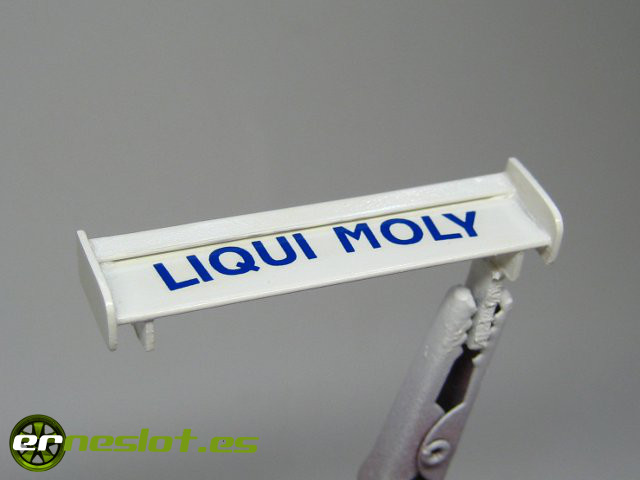
Finally, put a couple of exhaust pipes to the chassis made with a evergreen rod who gave an oval shape, such as original car exhaust pipes. In the next photo you can see before paint them with gray enamel.
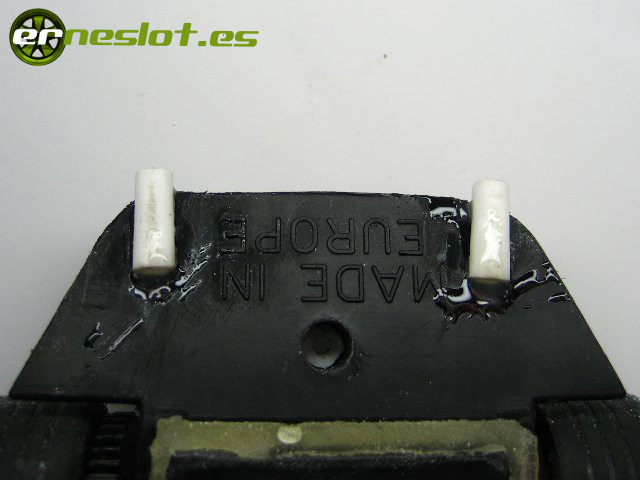
And finally, the car completely assembled looks as follows:
The result has left me a bit cold, especially because the color of the bodywork has been a bit yellow after applying the spray varnish (Vallejo). As happened with the Toyota Celica, the varnish has reacted with the white paint has yellowed an marred a bit the final result. Moreover, the car was correct.
Technically the car doens´t has any difficulty, but what has become clear to me when I made this car is that the decorations can not be taken as a minor job but we must put as much interest as for the more complex transformations to do a good work. Otherwise, this lack of interest is reflected in the final result, in this case, verging on mediocre.
Fortnightly updates, new cars and more in www.erneslot.es




